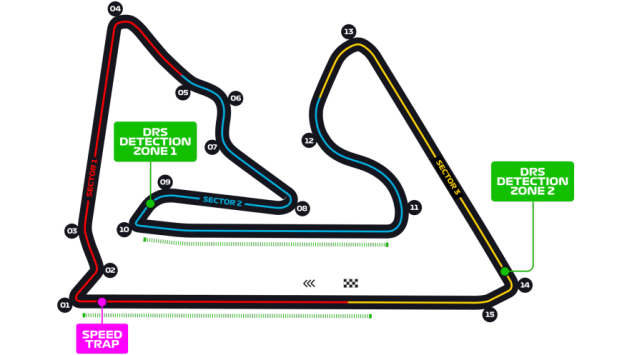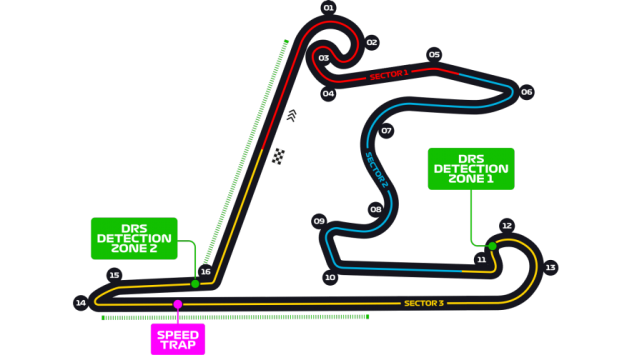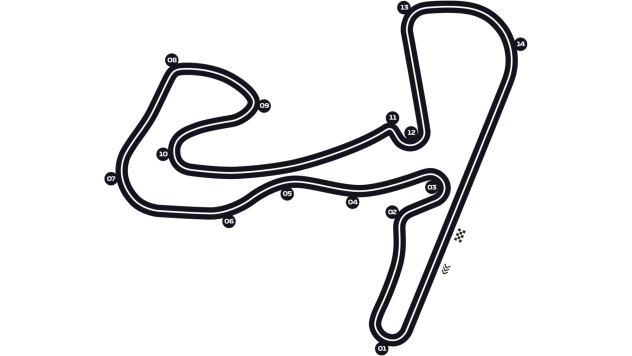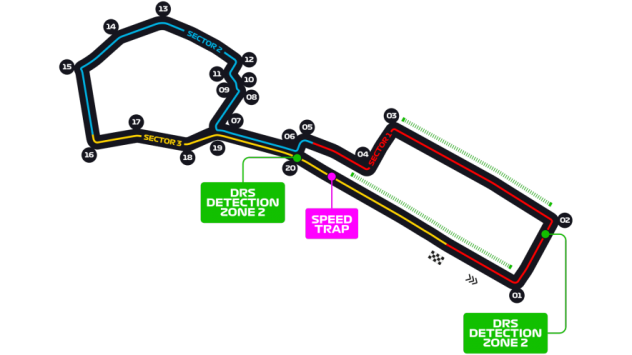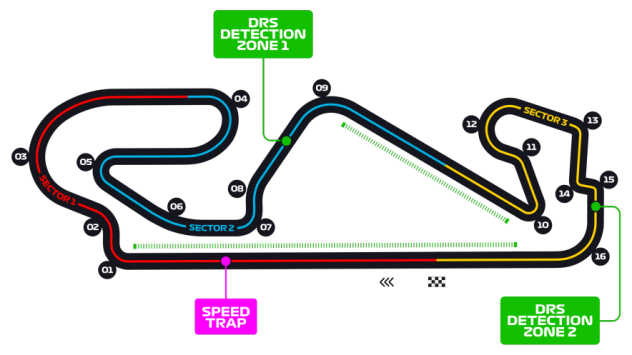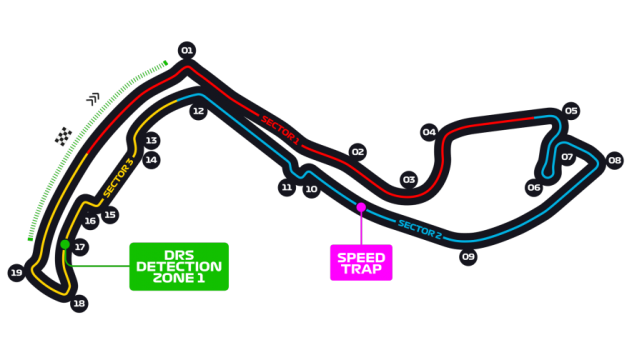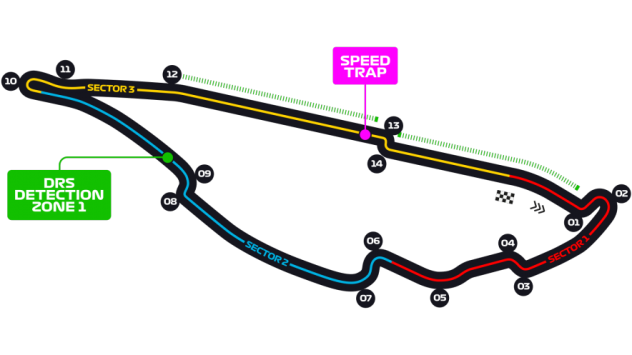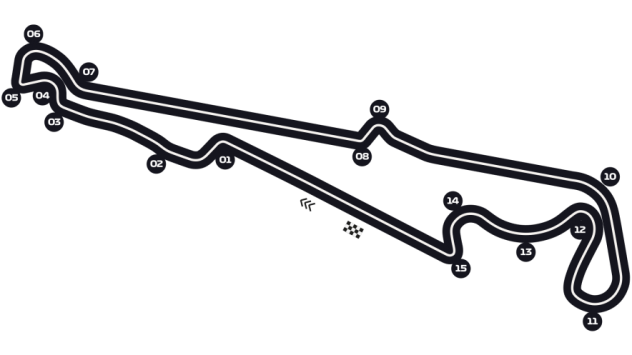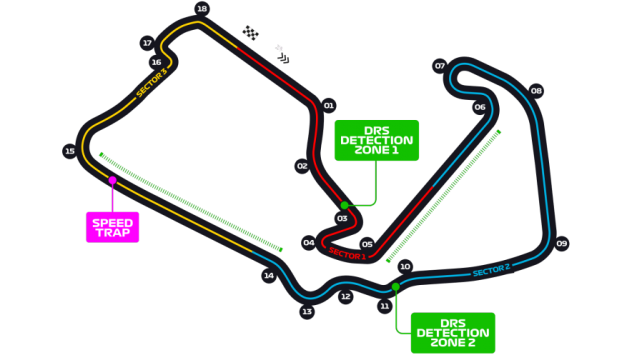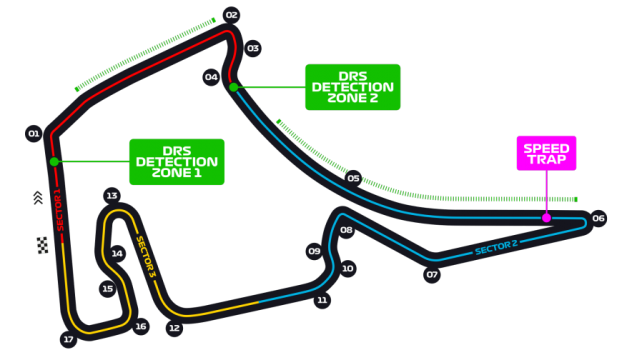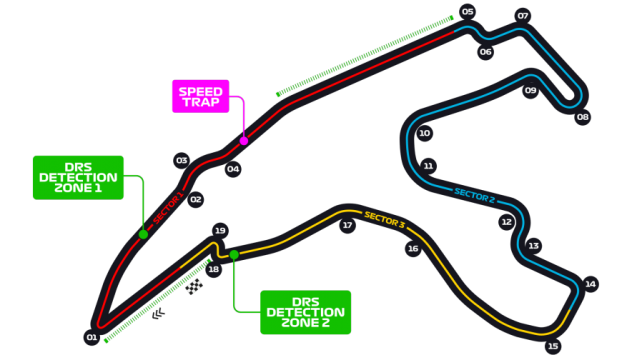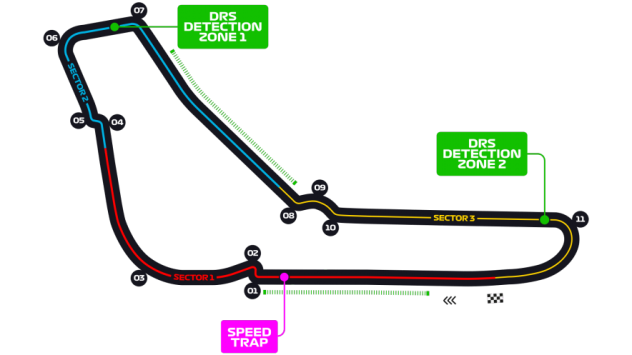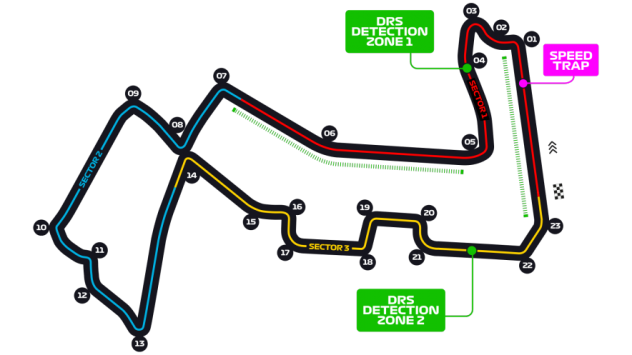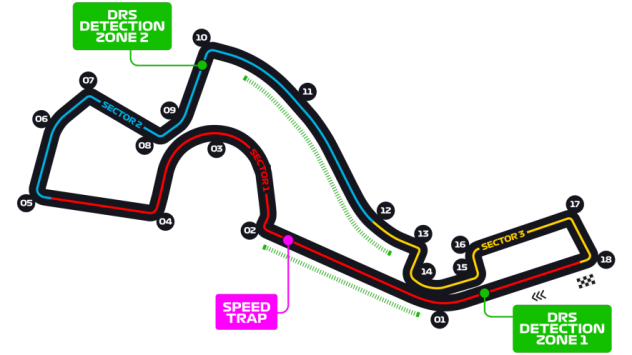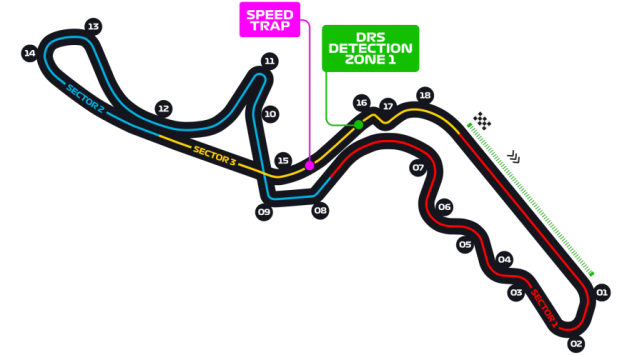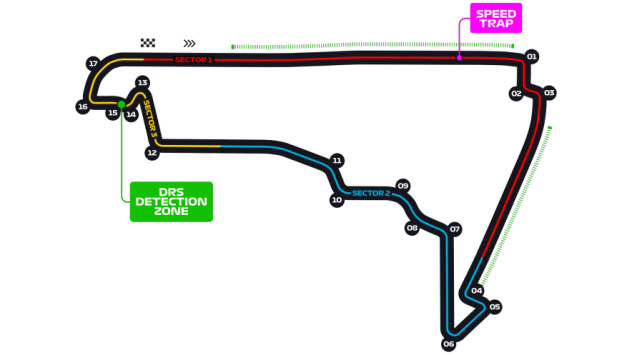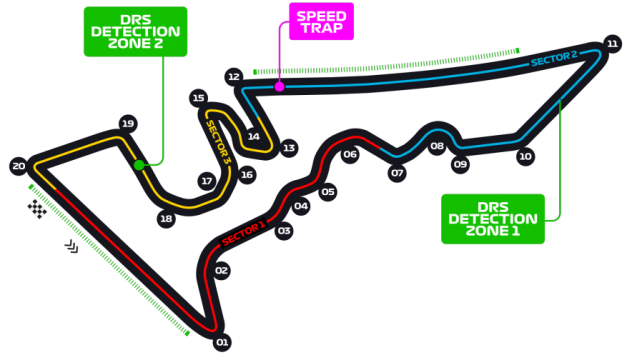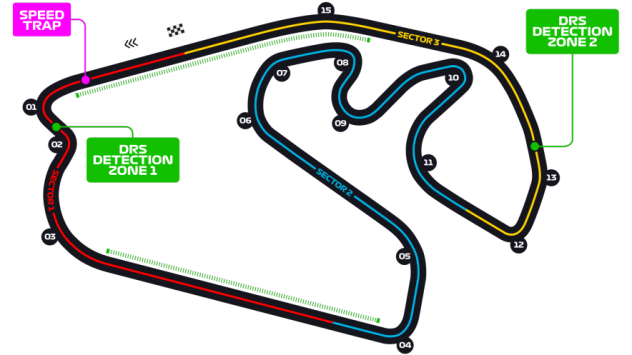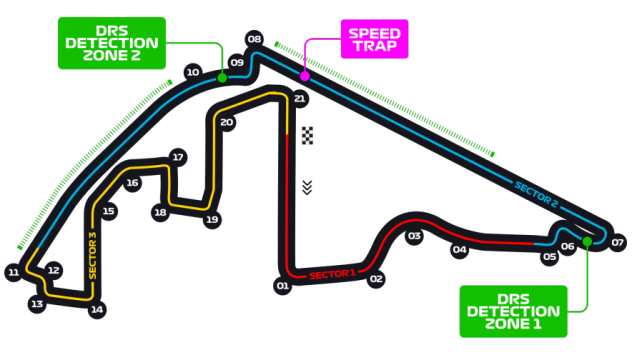
F1 Circuits
-
 AUSTRALIA
AUSTRALIA
-
 BAHRAIN
BAHRAIN
-
 CHINA
CHINA
-
 NETHERLANDS
NETHERLANDS
-
 AZERBAIJAN
AZERBAIJAN
-
 SPAIN
SPAIN
-
 MONACO
MONACO
-
 CANADA
CANADA
-
 FRANCE
FRANCE
-
 AUSTRIA
AUSTRIA
-
 GREAT BRITAIN
GREAT BRITAIN
-
 GERMANY
GERMANY
-
 HUNGARY
HUNGARY
-
 BELGIUM
BELGIUM
-
 ITALY
ITALY
-
 SINGAPORE
SINGAPORE
-
 RUSSIA
RUSSIA
-
 JAPAN
JAPAN
-
 MEXICO
MEXICO
-
 USA
USA
-
 BRAZIL
BRAZIL
-
 UAE
UAE
Melbourne Grand Prix Circuit 
- First Grand Prix: 1996
- Circuit Length: 5.3 km
- Turns: 16
- Race Distance: 307.574 km
- Number of Times Held: 8
- Record Lap: 1:22.887 (Joexx1188)
Results
| Season | Winner | 2nd Position | 3rd Position | Pole Position | Fastest lap |
|---|---|---|---|---|---|
| 4th (Super League) | atimgren | MQD94 | Xx-ITsJAX-xX | 1:19.990 atimgren | 1:22.887 Joexx1188 |
| 2nd (Premier Series) | POPE_taybz | SF-AS17 | Mettboy18 | 1:20.247 ITS_JulioPT | 1:23.702 SF-AS17 |
| 3rd (Super League) | nappula185 | MQD94 | Xx-ITsJAX-xX | 1:21.000 Xx-ITsJAX-xX | 1:23.567 pierro62930 |
| 1st (Premier Series) | Shanksta11 | X-Ace7-X | toussaint0208 | 1:22.015 toussaint0208 | 1:24.771 toussaint0208 |
| 2nd (Super League) | atimgren | Ess_Aych | toussaint0208 | 1:22.015 toussaint0208 | 1:24.771 toussaint0208 |
| 2nd (Super League) | nappula185 | Damian_va02 | Berkay_kv | 1:21.452 nappula185 | 1:24.449 nappula185 |
| 2nd (Super League) | goagola | Zzaza-22 | RyanStozza | 1:22.547 goagola | 1:25.624 SaboTheMister |
| 1st (Super League) | Red15-GRT- | vectro666 | egkas90 | 1:21.813 egkas90 | 1:25.290 egkas90 |
When was the track built?
The deal to host Formula 1 in Melbourne was done in 1993, with the decision taken to create a circuit using a mixture of the existing roads around the city’s Albert Park – mainly Aughtie Drive and Lakeside Drive if you fancy driving it yourself – with a little detour through the Lakeside Stadium’s car park.
When was its first Grand Prix?
Just four months after Adelaide held its last Australian Grand Prix at the end of 1995, the Formula 1 teams were back in Australia for Melbourne's first Grand Prix at the start of 1996. That race is most often remembered for Martin Brundle’s infamous Jordan crash at Turn 3 after he launched himself off the back of Johnny Herbert’s Sauber.
What’s the circuit like?
As a temporary facility, Albert Park can be quite bumpy, while the circuit at the start of the weekend is often slippery, rubbering in as the sessions progress. It’s also a circuit that requires a well-sorted chassis, with several spots on the track where the drivers require a reactive front end to allow them to chuck it into a corner – the main one being the rapid Turn 11-12 chicane. Melbourne is also one of the faster tracks on the calendar, with Lewis Hamilton’s 2018 pole lap set at an average of 235km/h.
Bahrain International Circuit 
- First Grand Prix: 2004
- Circuit Length: 5.4 km
- Turns: 15
- Race Distance: 308.238 km
- Number of Times Held: 6
- Record Lap: 1:27.464 (Daan_Snijder_21)
Results
| Season | Winner | 2nd Position | 3rd Position | Pole Position | Fastest lap |
|---|---|---|---|---|---|
| 6th (Super League) | NabilSlk | leocat0007 | POPE-taybz | 1:26.379 NabilSlk | 1:29.035 volanic |
| 4th (Premier Series) | kaasstengel148 | XnattyG | Geekfusion1 | 1:26.665 jutzikev | 1:28.354 jutzikev |
| 4th (Freshman League) | YT-DerEchte-btw | m-a-s-o-n-83 | unique-j | 1:27.065 unique-j | 1:28.914 unique-j |
| 5th (Super League) | Chris_EX_Stars | mahrez1097 | atimgren | 1:25.055 NabilSlk | 1:27.464 Daan_Snijder_21 |
| 3rd (Premier Series) | Absolut_11 | kaasstengel148 | Thunder5050 | 1:25.881 kaasstengel148 | 1:29.391 Frozer96 |
| 3rd (Freshman League) | RC_8_ | Gregsta048 | tonios60 | 1:25.711 RC_8_ | 1:28.530 PhantomRazgriz |
| 2nd (Freshman League) | Absolut_11 | jutzikev | tonios60 | 1:25.743 Absolut_11 | 1:28.766 RC_8_ |
| 1st (Freshman League) | hollandkampioen2 | LawJedi5000 | Timv2008_64 | 1:28.429 LawJedi5000 | 1:29.381 Pepalech |
| 1st (Super League) | Red15-GRT- | Markoes_hlb | GAVRANOVIC1991 | 1:27.810 egkas90 | 1:29.809 SaboTheMister |
When was the track built?
Ground was broken for the Bahrain International Circuit in December 2002. Like the Yas Marina Circuit in Abu Dhabi, the developers had a blank, sandy canvas to work with, and with that fashioned the technical, 5.4km track designed by Hermann Tilke.
When was its first Grand Prix?
It was 2004 when the drivers first lined up under an unusually cloudy sky for the inaugural Bahrain Grand Prix. The race was dominated (like many in 2004) by the two Ferraris, with Michael Schumacher winning out from Rubens Barrichello, while the crowds were also treated to a fantastic dog-fight between the Jaguar of Mark Webber and the Renault of Fernando Alonso.
What’s the circuit like?
You can usually expect great racing and decent amounts of overtaking in Bahrain, while the drivers have to contend with wind, racing under floodlights and the difficulty of finding a decent set-up with the wide temperature fluctuations between sessions. The track’s most challenging point is the tight, downhill, off-camber Turn 10 left-hander, while the fast run through Turn 12 is another highlight, allowing the racers to really feel their cars coming alive.
Shangai International Circuit 
- First Grand Prix: 2004
- Circuit Length: 5.4 km
- Turns: 16
- Race Distance: 305.066 km
- Number of Times Held: 15
- Record Lap: 1:32.123 (jetze_ofzo)
Results
| Season | Winner | 2nd Position | 3rd Position | Pole Position | Fastest lap |
|---|---|---|---|---|---|
| 6th (Super League) | POPE_taybz | toussaint0208 | pierro62930 | 1:31.440 Shanksta11 | 1:34.213 Shanksta11 |
| 4th (Premier Series) | kaasstengel148 | unique-j | XnattyG | 1:32.046 hollandkampioen2 | 1:35.223 Billymisu31 |
| 4th (Freshman League) | m-a-s-o-n-83 | unique-j | SaboTheMister | 1:31.925 m-a-s-o-n-83 | 1:35.275 unique-j |
| 5th (Super League) | ZeticOreoz | rickholt2004 | pierro62930 | 1:42.359 ZeticOreoz | 1:32.123 jetze_ofzo |
| 3rd (Premier Series) | Absolut_11 | Joexx1188 | kaasstengel148 | 1:30.567 Frozer96 | 1:33.194 Bonnieval99 |
| 3rd (Freshman League) | RC_8_ | Gregsta048 | PhantomRazgriz | 1:30.416 kebabbarigers | 1:34.218 SaboTheMister |
| 4th (Super League) | PlayDutchY | atimgren | pierro62930 | 1:30.400 Xx-ITsJAX-xX | 1:32.357 mahrez1097 |
| 2nd (Premier Series) | XnattyG | Absolut_11 | Mettboy18 | 1:30.656 ITS_JulioPT | 1:32.687 jetze_ofzo |
| 2nd (Freshman League) | RC_8_ | jutzikev | bruzzi07 | 1:29.990 jutzikev | 1:32.266 jutzikev |
| 1st (Freshman League) | LawJedi5000 | hollandkampioen2 | tietgatAntilopen | 1:31.420 Pepalech | 1:34.679 BramboSuperFuxia |
| 3rd (Super League) | atimgren | PlayDutchY | nappula185 | 1:46.828 pierro62930 | 1:34.922 atimgren |
| 1st (Premier Series) | Shanksta11 | toussaint0208 | X-Ace7-X | 1:32.559 Shanksta11 | 1:34.236 toussaint0208 |
| 2nd (Super League) | SaboTheMister | Zzaza-22 | goagola | 1:33.284 goagola | 1:36.812 GAVRANOVIC1991 |
| 2nd (Super League) | atimgren | donrajib_786 | pierro62930 | 1:32.399 atimgren | 1:35.116 Red15-GRT- |
| 2nd (Super League) | Toby_0603 | Damian_va02 | nappula185 | 1:31.897 nappula185 | 1:35.082 SimJoNator |
When was the track built?
In April 2003, a marshland in the Jiading District of Shanghai was earmarked for Formula 1 greatness. Eighteen months and around $450 million later, the state-of-the-art Shanghai International Circuit was complete.
When was its first Grand Prix?
The 2004 season featured two new races, one of which was the Chinese Grand Prix (the other was Bahrain). If either were added to try and stop Ferrari from winning everything, however, it didn’t work – Schumacher won in Bahrain, while Rubens Barrichello triumphed in China.
What’s the circuit like?
The circuit’s pleasing form when seen from the air – it’s designed to look like the Chinese symbol for ‘shang’, meaning upwards – is equally pleasing to the drivers on terra firma. There’s a unique start to the lap as the drivers fly into the ever-tightening Turns 1 and 2, before they dart left through 3 and 4. The super-high g force Turns 7 and 8 are loved by the drivers, while the circuit also features one of the longest straights on the calendar, the 1.2km tretchhat separates Turns 13-14.
Zandvoort Circuit 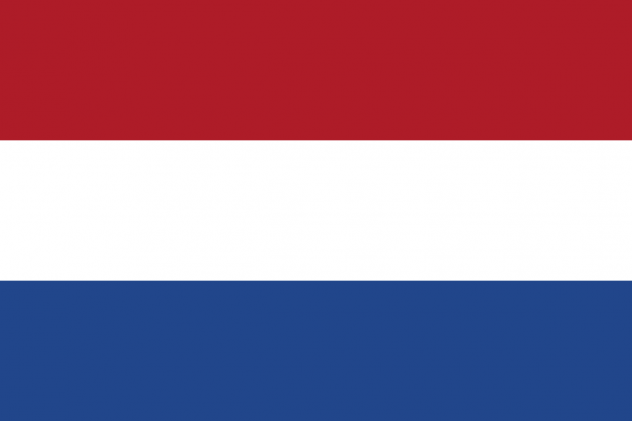
- First Grand Prix: 1952
- Circuit Length: 4.2 km
- Turns: 14
- Race Distance: 306.648 km
- Number of Times Held: 6
- Record Lap: 1:10.106 (atimgren)
Results
| Season | Winner | 2nd Position | 3rd Position | Pole Position | Fastest lap |
|---|---|---|---|---|---|
| 5th (Super League) | Chris_EX_Stars | Besaah | toussaint0208 | 1:08.893 mahrez1097 | 1:10.106 atimgren |
| 3rd (Premier Series) | Frozer96 | nappula185 | Absolut_11 | 1:09.208 kaasstengel148 | 1:20.335 Absolut_11 |
| 3rd (Freshman League) | RC_8_ | Gregsta048 | PhantomRazgriz | 1:10.182 Gregsta048 | 1:12.408 RC_8_ |
| 4th (Super League) | atimgren | donrajib_786 | jetze_ofzo | 1:08.561 atimgren | 1:10.595 atimgren |
| 2nd (Premier Series) | Besaah | POPE_taybz | jetze_ofzo | 1:19.615 OriolTG123 | 1:11.454 kebabbarigers |
| 2nd (Freshman League) | Absolut_11 | RC_8_ | jutzikev | 1:09.997 jutzikev | 1:13.263 Absolut_11 |
When was the track built?
Like its British counterpart and F1 mainstay, Silverstone, Zandvoort was borne out of enthusiasm for all things motorsports following the Second World War, and both tracks were inaugurated in the same year: 1948.
Baku City Circuit 
- First Grand Prix: 2016
- Circuit Length: 6.0 km
- Turns: 20
- Race Distance: 306.049 km
- Number of Times Held: 2
- Record Lap: 1:40.529 (Pearson-Jax)
Results
| Season | Winner | 2nd Position | 3rd Position | Pole Position | Fastest lap |
|---|---|---|---|---|---|
| 5th (Super League) | NabilSlk | Daan_Snijder_21 | mahrez1097 | 1:38.001 Pearson-Jax | 1:40.529 Pearson-Jax |
| 1st (Super League) | Red15-GRT- | Markoes_hlb | egkas90 | 1:40.393 egkas90 | 1:44.071 egkas90 |
When was the track built?
It wasn’t – Baku is the newest street circuit on the Formula 1 calendar, joining the ranks of Monaco, Melbourne and Singapore.
When was its first Grand Prix?
The first Grand Prix in Baku was held in 2016, as the European Grand Prix. That was followed by the inaugural Azerbaijan Grand Prix in 2017, which witnessed one of the biggest upsets of the season, with Daniel Ricciardo winning out from Valtteri Bottas and the Williams of Lance Stroll, while Lewis Hamilton and Sebastian Vettel engaged in some argy-bargy behind the Safety Car.
What’s the circuit like?
A mixture of wide and open and tight and twisty. The lonnnnng main straight along the Baku shoreline is a slipstreaming mecca, and with cars able to run three abreast into Turn 1, the action often looks more IndyCar than F1. However from there, the track loops around into the city’s narrow, winding Icheri Sheher old town, dramatically wending past Baku’s medieval city walls. As in Monaco, slightest mistakes are punished quickly and severely, while set-up wise, the teams are forced to choose between downforce for the twisty bits and less drag for the straight
Circuit de Barcelona-Catalunya 
- First Grand Prix: 1991
- Circuit Length: 4.6 km
- Turns: 16
- Race Distance: 307.104 km
- Number of Times Held: 7
- Record Lap: 1:17.250 (jetze_ofzo)
Results
| Season | Winner | 2nd Position | 3rd Position | Pole Position | Fastest lap |
|---|---|---|---|---|---|
| 4th (Super League) | atimgren | pierro62930 | toussaint0208 | 1:15.085 Xx-ITsJAX-xX | 1:17.250 jetze_ofzo |
| 2nd (Premier Series) | jetze_ofzo | XnattyG | Besaah | 1:15.622 POPE_taybz | 1:18.057 Kryptek_QN |
| 3rd (Super League) | PlayDutchY | nappula185 | Xx-ITsJAX-xX | 1:18.515 Xx-ITsJAX-xX | 1:20.228 atimgren |
| 1st (Premier Series) | toussaint0208 | Shanksta11 | fire-tornado39 | 1:19.148 toussaint0208 | 1:22.242 Tobster2710 |
| 2nd (Super League) | XDAN_LUTONIANX | nappula185 | zsf_limos | 1:18.284 nappula185 | 1:20.442 nappula185 |
| 2nd (Super League) | Ligin300 | ESS_AYCH | donrajib_786 | 1:18.251 enrico_flam | 1:21.372 ESS_AYCH |
| 2nd (Super League) | goagola | GAVRANOVIC1991 | Mettboy18 | 1:34.444 goagola | 1:21.157 goagola |
When was the track built?
The Circuit de Barcelona-Catalunya was built as part of the 1992 Barcelona Olympics development programme. The foundation stone was laid in 1989, while the first car race was a round of the 1991 Spanish Touring Car Championship.
When was its first Grand Prix?
Two weeks after the touring cars raced at Barcelona, it was Formula 1’s turn. The track enjoyed a sensational debut, with Nigel Mansell and Ayrton Senna’s famous eyeball-to-eyeball drag race down the straight, before Mansell took the lead and drove on to victory.
What’s the circuit like?
The drivers love the Circuit de Barcelona-Catalunya, which is just as well, because they spend huge amounts of time pounding around it during winter testing. The track is a good mix of high- and low-speed corners, with the challenging Turn 3 right-hander a great chance to evaluate the balance of the car your team’s designers have given you to fight with for the season.
Circuit de Monaco 
- First Grand Prix: 1950
- Circuit Length: 3.3 km
- Turns: 19
- Race Distance: 260.286 km
- Number of Times Held: 1
- Record Lap: 1:11.161 (Daan_Snijder_21)
Results
| Season | Winner | 2nd Position | 3rd Position | Pole Position | Fastest lap |
|---|---|---|---|---|---|
| 4th (Super League) | PlayDutchY | toussaint0208 | pierro62930 | 1:09.311 Xx-ITsJAX-xX | 1:11.161 Daan_Snijder_21 |
When was the track built?
In 1215, sort of – that’s when Monaco was first established as a colony of Genoa.
When was its first Grand Prix?
It was 1929 when racing engines first reverberated around the Principality, after cigarette manufacturer Antony Noghes decided to organise a race with his pals from the Automobile Club de Monaco. The race was part of the calendar in the first year of the Formula 1 World Championship in 1950, and hasn’t been off it since 1955.
What’s the circuit like?
Incredibly narrow and totally iconic. Nelson Piquet memorably described driving around Monaco as “like riding a bicycle around your living room”… which is fair. Despite that, it’s a challenge that nearly all drivers love, forcing them to put their skills on the line and rewarding millimetric accuracy. Overtaking on the tight streets is harder, however, with the 2003 Grand Prix witnessing a grand total of zero passing moves!
Circuit Gilles Villeneuve 
- First Grand Prix: 1978
- Circuit Length: 4.3 km
- Turns: 14
- Race Distance: 305.027 km
- Number of Times Held: 7
- Record Lap: 1:10.458 (pierro62930)
Results
| Season | Winner | 2nd Position | 3rd Position | Pole Position | Fastest lap |
|---|---|---|---|---|---|
| 6th (Super League) | Nabilslk | POPE_taybz | toussaint0208 | 1:09.322 F1Lover44 | 1:11.435 Bonnieval99 |
| 4th (Premier Series) | jutzikev | geekfusion1 | kaasstengel148 | 1:09.582 kaasstengel148 | 1:20.082 jutzikev |
| 5th (Super League) | ZeticOreoz | mahrez1097 | atimgren | 1:08.158 NabilSlk | 1:10.458 pierro62930 |
| 3rd (Premier Series) | Joexx1188 | F1_Lover44 | Absolut_11 | 1:08.647 kaasstengel148 | 1:20.041 Joexx1188 |
| 3rd (Freshman League) | RC_8_ | kebabbarigers | PhantomRazgriz | 1:09.229 PhantomRazgriz | 1:12.089 PhantomRazgriz |
| 2nd (Super League) | danthebluebird92 | Berkay_kv | Xx-ITsJAX-xX | 1:09.383 nappula185 | 1:12.492 nappula185 |
| 2nd (Super League) | atimgren | Red-15-GRT | pierro62930 | 1:09.769 Red-15-GRT- | 1:11.348 ESS_AYCH |
| 2nd (Super League) | Infamella_92 | GAVRANOVIC1992 | SaboTheMister | Infamella_92 | 1:12.802 GAVRANOVIC1991 |
| 1st (Super League) | PlayDutchY | Wes--GS | egkas90 | 1:14.989 PlayDutchY | 1:11.171 PlayDutchY |
When was the track built?
The man-made Notre Dame Island in the middle of the St Lawrence River was created for the 1967 Expo 67 World's Fair. Once the expo and the ensuing 1976 Montreal Summer Olympics had left town, some clever people decided to make a race track out of the island’s roads. And lo, the Circuit Ile Notre-Dame, as it then was, came to be.
When was its first Grand Prix?
With the Canadian Grand Prix having been in search of a permanent home for a number of years in the 1960s and 1970s, the Circuit Ile Notre-Dame first hosted the race in 1978. Fittingly, Gilles Villeneuve claimed his maiden win, at the track that would end up bearing his name.
What’s the circuit like?
The fast, low-downforce circuit is one of the drivers’ favourites. The track is quite stop-start, with lots of heavy-braking chicanes and the famous hairpin to get the anchors working hard. Out of the corners, though, the track is quick and flowing, while the most iconic piece of the circuit comes right at the end of the lap: the Wall of Champions, so-called after excursions into it from Damon Hill, Jacques Villeneuve and Michael Schumacher during the 1999 Canadian Grand Prix weekend.
Circuit Paul Ricard 
- First Grand Prix: 2018
- Circuit Length: 5.8 km
- Turns: 15
- Race Distance: 309.069 km
- Number of Times Held: 6
- Record Lap: 1:31.667 (Chris_EX_Stars)
Results
| Season | Winner | 2nd Position | 3rd Position | Pole Position | Fastest lap |
|---|---|---|---|---|---|
| 4th (Freshman League) | unique-j | DerEchte-btw | thabi_topdecks | 1:30.047 unique-j | 1:32.608 Tunturipaaryna |
| 5th (Super League) | ZeticOreoz | mahrez1097 | pierro62930 | 1:27.455 Pearson-jax | 1:31.667 Chris_EX_Stars |
| 3rd (Premier Series) | Absolut_11 | Frozer96 | kaasstengel148 | 1:28.956 B4U-DIE83 | 1:32.237 Frozer96 |
| 3rd (Freshman League) | tonios60 | Tunturipaaryna | RC_8_ | 1:28.233 leocat0007 | 1:32.974 unique_j |
| 2nd (Freshman League) | jutzikev | RC_8_ | tonios60 | 1:28.679 Absolut_11 | 1:38.577 Absolut_11 |
| 3rd (Super League) | PlayDutchY | nappula185 | pierro62930 | 1:31.423 PlayDutchY | 1:33.359 MQD94 |
| 1st (Premier Series) | nappula185 | toussaint0208 | Shanksta11 | 1:31.097 SaboTheMister | 1:33.426 nappula185 |
When was the track built?
Work began on pastis magnate Paul Ricard’s track in 1969, with French racers Jean-Pierre Beltoise and Henri Pescarolo acting as consultants on the layout. Racing began at the circuit a year later.
When was its first Grand Prix?
Formula 1 hit the Circuit Paul Ricard in 1971, with Jackie Stewart winning the inaugural race in his Tyrrell 003.
What’s the circuit like?
The Circuit Paul Ricard’s even distribution of high-, medium- and low-speed corners is a key reason why it’s one of the most used test circuits in the world (the typically good weather is another). F1 drivers love the 290km/h right-hander at Signes and the 5g joyride of the following Beausset bend, while the circuit’s 2018 return to the F1 calendar showed that the French Grand Prix track is a bit of an overtaking gem.
Red Bull Ring 
- First Grand Prix: 1970
- Circuit Length: 4.3 km
- Turns: 10
- Race Distance: 306.452 km
- Number of Times Held: 12
- Record Lap: 1:04.866 (jutzikev)
Results
| Season | Winner | 2nd Position | 3rd Position | Pole Position | Fastest lap |
|---|---|---|---|---|---|
| 6th (Super League) | pierro62930 | POPE_taybz | Shanksta11 | 1:03.857 leocat0007 | 1:05.387 POPE_taybz |
| 4th (Premier Series) | hollandkampioen2 | Canan2005 | unique-j | 1:04.073 Kryptek_QN | 1:05.868 GeekFusion1 |
| 4th (Freshman League) | unique-j | YT-DerEchte-btw | SaboTheMister | 1:04.236 Thabi_topdecks | 1:05.583 Thabi_topdecks |
| 5th (Super League) | mahrez1097 | NabilSlk | NomarShadow12 | 1:02.918 NabilSlk | 1:06.477 ZeticOreoz |
| 3rd (Premier Series) | kaasstengel148 | Frozer96 | Absolut_11 | 1:03.413 kaasstengel148 | 1:05.703 Shanksta11 |
| 3rd (Freshman League) | RC_8_ | Janne475 | Gin_and_Juice97 | 1:03.849 tonios60 | 1:06.393 Deadly_Jason |
| 4th (Super League) | pierro62930 | atimgren | PlayDutchY | 1:02.819 atimgren | 1:04.866 jutzikev |
| 2nd (Premier Series) | jutzikev | Absolut_11 | XnattyG | 1:04.002 jetze_ofzo | 1:05.509 jutzikev |
| 2nd (Freshman League) | Absolut_11 | tonios60 | RC_8_ | 1:03.372 jutzikev | 1:05.531 tonios60 |
| 1st (Freshman League) | XnattyG | hollandkampioen2 | LawJedi5000 | 1:04.737 Pepalech | 1:07.164 DirtyLarry90 |
| 3rd (Super League) | nappula185 | PlayDutchY | donrajib_786 | 1:04.606 atimgren | 1:06.978 ESS_AYCH |
| 1st (Premier Series) | toussaint0208 | OneShoot2Down | Shanksta11 | 1:04.903 fire-tornado39 | 1:08.021 GAVRANOVIC1991 |
| 2nd (Super League) | Xx-ITsJAX-xX | Damian_va02 | Berkay_kv | 1:05.284 Berkay_kv | 1:07.572 Berkay_kv |
| 2nd (Super League) | PlayDutchY | Red-15-GRT- | Ligin300 | 1:04.508 atimgren | 1:07.151 Red-15-GRT |
| 2nd (Super League) | SaboThemIster | goagola | TRIPLE-OH | 1:06.063 goagola | 1:08.738 SaboTheMister |
When was the track built?
The fearsome, original Osterreichring was originated in 1969 as a replacement for the Zeltweg airfield circuit. The track known today as the Red Bull Ring was more or less created over the winter of 1995-6, when Hermann Tilke was engaged to turn the Osterreichring into a shorter, more modern race track.
When was its first Grand Prix?
The A1-Ring, as it was then called, was opened in 1996, with Formula 1 arriving at the circuit a year later. Jacques Villeneuve won the race, while Jean Alesi had a spectacular crash when his Benetton climbed up the Ferrari of Eddie Irvine. Alesi’s team mate Gerhard Berger, meanwhile, used his home Grand Prix to announce his F1 retirement.
What’s the circuit like?
It’s only wee, bless it, but the Red Bull Ring packs a lot into a short lap. The first half rewards power, as the cars blast along three straights separated by a pair of uphill right-handers. But then as the drivers work their way downhill, the circuit becomes a regular toboggan ride, as the cars canyon through a series of quick corners, including the exhilarating Rindt right-hander, named for Austria’s first F1 champion.
Silverstone Circuit 
- First Grand Prix: 1950
- Circuit Length: 5.8 km
- Turns: 18
- Race Distance: 306.198 km
- Number of Times Held: 12
- Record Lap: 1:26.809 (XnattyG)
Results
| Season | Winner | 2nd Position | 3rd Position | Pole Position | Fastest lap |
|---|---|---|---|---|---|
| 6th (Super League) | leocat0007 | Shanksta11 | jutzikev | 1:26.927 leocat0007 | 1:28.022 Mc_Koelie |
| 4th (Premier Series) | kaasstengel148 | jutzikev | hollandkampioen2 | 1:26.918 juzikev | 1:29.261 hollandkampioen2 |
| 4th (Freshman League) | unique-j | thabi_topdecks | YT-Derechte-btw | 1:27.232 unique-j | 1:29.664 unique-j |
| 5th (Super League) | atimgren | ZeticOreoz | mahrez1097 | 1:24.250 Pearson-Jax | 1:26.809 XnattyG |
| 3rd (Premier Series) | kaasstengel148 | benroberts_44 | F1Lover44 | 1:24.835 kaasstengel148 | 1:26.748 nappula185 |
| 3rd (Freshman League) | RC_8_ | Janne475 | BlackCharizard3 | 1:25.144 PhantomRazgriz | 1:26.870 RC_8_ |
| 4th (Super League) | Xx-ITsJAX-xX | PlayDutchY | pierro62930 | 1:24.395 pierro62930 | 1:27.691 PlayDutchY |
| 2nd (Premier Series) | jutzikev | XnattyG | Absolut_11 | 1:24.791 astonf11996 | 1:27.313 SF-AS17 |
| 2nd (Freshman League) | Absolut_11 | RC_8_ | tedmc24 | 1:25.209 RC_8_ | 1:26.885 Absolut_11 |
| 3rd (Super League) | pierro62930 | PlayDutchY | donrajib_786 | 1:26.886 pierro62930 | 1:30.029 nappula185 |
| 1st (Premier Series) | toussaint0208 | Shanksta11 | OneShoot2Down | 1:27.698 Shanksta11 | 1:30.148 SaboTheMister |
| 2nd (Super League) | Xx-ITsJAX-xX | Toby_0603 | Damian_va02 | 1:27.717 Toby_0603 | 1:30.852 Xx-ITsJAX-xX |
| 2nd (Super League) | PlayDutchY | ESS_AYCH | donrajib_786 | 1:27.007 atimgren | 1:29.945 ESS_AYCH |
| 2nd (Super League) | goagola | AlexGunnerMac | Zzaza-22 | 1:28.584 goagola | 1:41.937 goagola |
| 1st (Super League) | vectro666 | AlePetru_17 | Luke_E_90 | 1:28.370 vectro666 | 1:30.536 Red15-GRT- |
When was the track built?
Little did those laying the perimeter road to the RAF Silverstone airfield in 1942 know that they were setting down what would become one of the world’s greatest race tracks. But, well, they were! The Silverstone circuit was first used for a proper motor race in 1947 – although sadly, a local sheep lost its life during the proceedings…
When was its first Grand Prix?
Silverstone was the first Grand Prix, hosting the inaugural Formula 1 World Championship round on May 13 1950. Old campaigner Giuseppe Farina, who’d take that year’s title, won the race in his Alfa Romeo 158.
What’s the circuit like?
At the 2018 British Grand Prix, Lewis Hamilton compared a flat-out lap around Silverstone to flying a fighter jet, which should tell you all you need to know about the Northamptonshire circuit. Despite numerous layout changes over the years, Silverstone has always maintained its essential character as one of the fastest tracks on the F1 calendar, while historic corners like Maggotts, Becketts and Abbey provide some of the biggest challenges for racing drivers anywhere in the world.
Hockenheimring 
- First Grand Prix: 1970
- Circuit Length: 4.5 km
- Turns: 17
- Race Distance: 306.458 km
- Number of Times Held: 3
- Record Lap: 1:14.519 (XNattyG)
Results
| Season | Winner | 2nd Position | 3rd Position | Pole Position | Fastest lap |
|---|---|---|---|---|---|
| 3rd (Super League) | PlayDutchY | Jo-Jo-Power | pierro62930 | 1:12.307 PlayDutchY | 1:14.619 Kobayashi_Japan1 |
| 1st (Premier Series) | Shanksta11 | DirtyLarry90 | toussaint0208 | 1:12.691 Timv2008_64 | 1:14.555 Timv2008_64 |
| 1st (Freshman League) | hollandkampioen2 | tietgatAntilopen | Pepalech | 1:11.139 Pepalech | 1:14.519 XnattyG |
When was the track built?
Hockenheim dates all the way back to 1932, when it was created by Mercedes as a test track for their cars, in particular to fettle them for the Tripoli Grand Prix. The original track was an enormous 12km triangular affair – in fact it was called the ‘Dreieckskurs’, or 'Triangle Track' – that speared off to the outskirts of nearby Oftersheim before looping back via the current B291.
When was its first Grand Prix?
The Dreieckskurs was shortened in 1938, while following a further 1960s update from Dutchman John Hugenholtz – the man responsible for Suzuka – Formula 1 came to Hockenheim in 1970. That year’s world-champion-to-be, Jochen Rindt, won the race by just 0.7 seconds from main title rival Jacky Ickx.
What’s the circuit like?
Up until 2002, Hockenheim’s design saw the cars roar out into the forest before looping around the Ostkurve and steaming back into the stadium. In 2002, the track was truncated, with the cars now turning right shortly after Turn 1 and bisecting the original track. Hockenheim is still a fast track, though, with Sebastian Vettel recording a 231km/h average during his 2018 pole lap.
Hungaroring 
- First Grand Prix: 1986
- Circuit Length: 4.3 km
- Turns: 14
- Race Distance: 306.063 km
- Number of Times Held: 4
- Record Lap: 1:15.633 (atimgren)
Results
| Season | Winner | 2nd Position | 3rd Position | Pole Position | Fastest lap |
|---|---|---|---|---|---|
| 6th (Super League) | POPE_taybz | pierro62930 | jutzikev | 1:15.527 jutzikev | 1:18.517 POPE_taybz |
| 4th (Premier Series) | kaasstengel148 | jutzikev | hollandkampioen2 | 1:15.928 kaasstengel148 | 1:17.253 jutzikev |
| 4th (Freshman League) | unique-j | Thabi_topdecks | YT-DerEchte-btw | 1:15.626 YT-DerEchte-btw | 1:17.445 unique-j |
| 4th (Super League) | PlayDutchY | mahrez1097 | pierro62930 | 1:28.374 PlayDutchY | 1:15.633 atimgren |
| 2nd (Premier Series) | XnattyG | Besaah | Mettboy18 | 1:14.625 jutzikev | 1:16.515 Absolut_11 |
| 3rd (Super League) | pierro62930 | toussaint0208 | donrajib_786 | 1:17.360 toussaint0208 | 1:19.144 atimgren |
| 1st (Premier Series) | Shanksta11 | toussaint0208 | Tobster2710 | 1:29.421 Shanksta11 | 1:20.008 toussaint0208 |
When was the track built?
Work began on the Hungaroring in 1985, and the track was race-ready just nine months later. The Hungarian government had originally considered reviving the old Nepliget park circuit in Budapest in a bid to host Formula 1 in the country, but in the end decided to create a purpose-built facility instead.
When was its first Grand Prix?
The year was 1986. Nelson Piquet won the first F1 race around the Hungaroring, famously slithering his Williams around the outside of Ayrton Senna’s Lotus to take the lead.
What’s the circuit like?
The lack of straights at the Hungaroring often sees it compared to a karting circuit – and it’s true, the resemblance is uncanny. With several series of corners to string together, teams opt for Monaco levels of downforce, with a well-sorted chassis tending to be rewarded over horsepower given the short straights on offer. It’s a challenge many of the drivers relish, however, with finding a good rhythm key to setting fast lap times.
Circuit de Spa-Francorchamps 
- First Grand Prix: 1950
- Circuit Length: 7.0 km
- Turns: 19
- Race Distance: 308.052 km
- Number of Times Held: 8
- Record Lap: 1:45.011 (rickholt2004)
Results
| Season | Winner | 2nd Position | 3rd Position | Pole Position | Fastest lap |
|---|---|---|---|---|---|
| 5th (Super League) | NabilSlk | ZeticOreoz | Pearson-Jax | 1:41.254 mahrez1097 | 1:45.011 rickholt2004 |
| 3rd (Premier Series) | nappula185 | kaasstengel148 | Shanksta11 | 1:41.834 Shanksta11 | 1:45.065 Shanksta11 |
| 3rd (Freshman League) | RC_8_ | Gregsta048 | YT-DerEchte-btw | 1:42.360 PhantomRazgriz | 1:45.634 RC_8_ |
| 2nd (Freshman League) | jutzikev | Absolut_11 | tonios60 | 1:42.403 RC_8_ | 1:45.076 jutzikev |
| 1st (Freshman League) | tietgatAntilopen | Timv2008_64 | hollandkampioen2 | 1:43.721 Pepalech | 1:47.291 DirtyLarry90 |
| 1st (Premier Series) | toussaint0208 | Shanksta11 | Tobster2710 | 1:43.661 toussaint0208 | 1:47.278 toussaint0208 |
| 3rd (Super League) | PlayDutchY | atimgren | pierro62930 | 1:43.462 atimgren | 1:57.970 MQD94 |
| 1st (Super League) | SaboTheMister | crazah1990 | Wes--GS | 1:57.287 vectro666 | 1:48.126 SaboTheMister |
When was the track built?
The original, triangle-shaped track was built in 1921, with designers Jules de Thier and Henri Langlois van Ophem using public roads between the towns of Francorchamps, Malmedy, and Stavelot to create an amazing 14.9km circuit taking in the forests and rolling hills of the beautiful Ardennes region. The track was redeveloped in 1979, and although the new circuit is only half the original's length, it’s still the longest on the current calendar at 7.004km.
When was its first Grand Prix?
Having hosted a non-championship Grand Prix as long ago as 1924, Belgium’s iconic circuit was one of just seven to be part of Formula 1’s maiden championship in 1950. That race was won by the legendary Juan Manuel Fangio, who led home an Alfa Romeo one-two ahead of team mate Nino Farina.
What’s the circuit like?
Spa is among Formula 1 drivers’ most loved tracks, with its mix of long straights and challenging fast corners allowing them to push their cars to the edge of their capabilities – if it’s dry, that is. The size of the track and the nature of Belgian weather means it can sometimes be raining on one part of the track and dry on another, meaning grip can vary from one corner to the next. Keep an eye on the thrilling Eau Rouge, arguably the most famous sequence of corners in the world, as the drivers flick left, right and then up the hill through Raidillon.
Autodromo Nazionale Di Monza 
- First Grand Prix: 1950
- Circuit Length: 5.7 km
- Turns: 11
- Race Distance: 306.072 km
- Number of Times Held: 10
- Record Lap: 1:20.092 (pierro62930)
Results
| Season | Winner | 2nd Position | 3rd Position | Pole Position | Fastest lap |
|---|---|---|---|---|---|
| 6th (Super League) | POPE_taybz | jutzikev | toussaint0208 | 1:20.170 POPE_taybz | 1:28.870 jutzikev |
| 4th (Premier Series) | hollankampioen2 | kaasstengel148 | Hebbelerinho | 1:20.379 jutzikev | 1:22.233 XnattyG |
| 4th (Freshman League) | YT-DerEchte-btw | Thabi_topdecks | m-a-s-o-n-83 | 1:20.530 Thabi_topdecks | 1:21.441 unique_j |
| 5th (Super League) | mahrez1097 | ZeticOreoz | atimgren | 1:18.153 atimgren | 1:20.092 pierro62930 |
| 3rd (Premier Series) | nappula185 | kaasstengel148 | Shanksta11 | 1:18.512 kaasstengel148 | 1:21.729 nappula185 |
| 3rd (Freshman League) | RC_8_ | Gin_and_Juice97 | Gregsta048 | 1:19.590 Gregsta048 | 1:22.732 AlexGunnerMac |
| 4th (Super League) | mahrez1097 | PlayDutchY | pierro62930 | 1:18.691 mahrez1097 | 1:21.851 atimgren |
| 2nd (Premier Series) | jetze_ofzo | Besaah | Absolut_11 | 1:18.611 jetze_ofzo | 1:20.999 Mettboy18 |
| 2nd (Freshman League) | Absolut_11 | tonios60 | jutzikev | 1:30.316 Absolut_11 | 1:21.731 Absolut_11 |
| 2nd (Super League) | PlayDutchY | pierro62930 | atimgren | 1:19.459 atimgren | 1:21.638 PlayDutchY |
| 2nd (Super League) | Xx-ITsJAX-xX | nappula185 | Damian_va02 | 1:31.481 nappula185 | - |
| 2nd (Super League) | goagola | GAVRANOVIC1991 | SaboTheMister | 1:20.842 goagola | 1:23.969 goagola |
| 1st (Super League) | Wes--GS | Markoes_hlb | egkas90 | 1:20.470 Wes--GS | 1:23.811 egkas90 |
When was the track built?
Constructed in just 110 days in 1922, the Autodromo Nazionale Monza was the world’s third purpose-built race track, coming after Brooklands in the UK and Indianapolis in the US. Like those two tracks, the original circuit featured a daunting series of banked curves, as well as much of the ‘outfield’ section that’s still in use today.
When was its first Grand Prix?
Monza opened its doors on September 3 1922, just a week before it hosted that year’s Italian Grand Prix. It was then part of the original Formula 1 calendar in 1950, and has held the Italian Grand Prix every year bar one since.
What’s the circuit like?
Rapido! Formula 1’s fastest ever lap was set at Monza – Williams driver Juan Pablo Montoya’s 260.6km/h effort during practice for the 2004 Grand Prix – which should give you some idea of the nature of the track the locals call ‘La Pista Magica’. Cars are on full throttle for 80% of the lap, and hit their Vmax on the circuit’s 1.1km start/finish straight. From there, they roar off into the historic park section, where a series of big stops into tight chicanes give the brakes a good workout.
Marina Bay Street Circuit 
- First Grand Prix: 2008
- Circuit Length: 5.0 km
- Turns: 23
- Race Distance: 308.706 km
- Number of Times Held: 9
- Record Lap: 1:36.400 (atimgren)
Results
| Season | Winner | 2nd Position | 3rd Position | Pole Position | Fastest lap |
|---|---|---|---|---|---|
| 6th (Super League) | leocat0007 | POPE_taybz | MC_Koelie | 1:36.146 leocat0007 | 1:37.568 pierro62930 |
| 4th (Premier Series) | Thunder5050 | XNattyG | tigerassassin99 | 1:36.040 Kryptek_QN | 1:38.555 Kryptek_QN |
| 5th (Super League) | ZeticOreoz | Pearson-Jax | atimgren | 1:50.460 ZeticOreoz | 1:36.400 atimgren |
| 3rd (Premier Series) | Shanksta11 | nappula185 | Absolut_11 | 1:35.406 benroberts_44 | 1:38.322 nappula185 |
| 2nd (Premier Series) | POPE_taybz | Absolut_11 | XnattyG | 1:35.975 Kryptek_QN | 1:37.859 Besaah |
| 3rd (Super League) | toussaint0208 | atimgren | donrajib_786 | 1:35.940 atimgren | 1:41.992 pierro62930 |
| 1st (Premier Series) | PlayDutchY | toussaint0208 | OneShoot2Down | 1:56.652 PlayDutchY | 1:38.349 PlayDutchY |
| 2nd (Super League) | nappula185 | Damian_va02 | Berkay_kv | 1:36.352 nappula185 | 1:38.197 nappula185 |
| 2nd (Super League) | PlayDutchY | ESS_AYCH | pierro62930 | 1:36.172 PlayDutchY | 1:40.279 PlayDutchY |
| 2nd (Super League) | goagola | GAVRANOVIC1991 | Mettboy18 | 1:38.159 goagola | 1:43.322 goagola |
When was the track built?
The Marina Bay Circuit arrived on the scene in 2008. A street track with the city's famous skyline as its spectacular backdrop, the initial circuit plan by Herman Tilke was refined by KBR Inc, while the event has quickly established itself as one of the standouts on the F1 calendar.
When was its first Grand Prix?
In 2008, Singapore had the honour of hosting the first night-time race in F1 history. The Grand Prix – the 15th round of that season – proved a huge hit with the teams and drivers, while Renault’s Fernando Alonso claimed a controversial victory.
What’s the circuit like?
The 5.063km Marina Bay Circuit is one of the most physically demanding on the calendar, its bumpy street surface coupled with humid conditions giving the drivers plenty to think about. With 23 corners, they are working the wheel a lot, too, around the high-speed lap – the physical stress causing them to lose as much as 3kg over the course of a race. The circuit also boasts some of the most unique features of any track on the F1 calendar, including Turn 18, which actually sees the drivers pass underneath a grandstand.
Sochi Autodrom 
- First Grand Prix: 2014
- Circuit Length: 5.8 km
- Turns: 18
- Race Distance: 309.745 km
- Number of Times Held: 3
- Record Lap: 1:33.537 (tonios60)
Results
| Season | Winner | 2nd Position | 3rd Position | Pole Position | Fastest lap |
|---|---|---|---|---|---|
| 6th (Super League) | leocat0007 | pierro62930 | MC_Koelie | 1:31.057 leocat0007 | 1:33.438 leocat0007 |
| 4th (Premier Series) | Kryptek_QN | unique-j | Hebbelerinho | 1:31.399 Kryptek_QN | 1:33.829 revkoiv |
| 4th (Freshman League) | unique-j | Thabi_Topdecks | M-A-S-O-N-83 | 1:31.092 Thabi_Topdecks | 1:34.036 YT-DerEchte-btw |
| 2nd (Freshman League) | Absolut_11 | RC_8_ | jutzikev | 1:31.612 Absolut_11 | 1:33.537 tonios60 |
| 3rd (Super League) | donrajib_786 | pierro62930 | Xx-ITsJAX-xX | 1:31.860 atimgren | 1:35.753 atimgren |
| 1st (Premier Series) | toussaint0208 | SaboTheMister | Tobster2710 | 1:43.738 toussaint0208 | 1:36.578 GAVRANOVIC1991 |
When was the track built?
Designed by Hermann Tilke, the Sochi Autodrom is effectively a street circuit, evolving out of the internal roads of the park built for the city’s 2014 Winter Olympics.
When was its first Grand Prix?
Formula 1’s first ever Russian Grand Prix took place on October 12 2014. The race was won by Mercedes’ Lewis Hamilton, who was midway through a five-race winning streak that would ultimately see him clinch that year’s drivers’ title.
What’s the circuit like?
Looking at a map of the track, your eye can’t help but be drawn to the epic Turn 3, a 750m constant-radius left-hander taking the drivers around the outside of the dramatic Poyushchiye fountain. The rest of the track is characterised by a series of 90-degree bends coupled to some rapid, flowing straights-that-aren’t-straight.
Suzuka International Racing Course 
- First Grand Prix: 1987
- Circuit Length: 5.8 km
- Turns: 18
- Race Distance: 307.471 km
- Number of Times Held: 8
- Record Lap: 1:28.095 (rickholt2004)
Results
| Season | Winner | 2nd Position | 3rd Position | Pole Position | Fastest lap |
|---|---|---|---|---|---|
| 3rd (Freshman League) | AlexGunnerMac | RC_8_ | unique_j | 1:27.261 RC_8_ | 1:29.933 PhantomRazgriz |
| 4th (Super League) | pierro62930 | rickholt2004 | PlayDutchY | 1:26.342 atimgren | 1:28.850 Xx-ITsJAX-xX |
| 2nd (Premier Series) | Absolut_11 | XnattyG | POPE_taybz | 1:26.480 Besaah | 1:28.095 rickholt2004 |
| 2nd (Freshman League) | rickholt2004 | tonios60 | jutzikev | 1:26.456 rickholt2004 | 1:29.308 jutzikev |
| 2nd (Super League) | nappula185 | FTRL_Oxii | Xx-ITsJAX-xX | 1:29.597 nappula185 | 1:31.607 nappula185 |
| 2nd (Super League) | atimgren | Red15-GRT- | PlayDutchY | 1:28.639 PlayDutchY | 1:41.721 PlayDutchY |
| 2nd (Super League) | B4U-DIE83 | GAVRANOVIC1991 | goagola | 1:30.363 B4U-DIE83 | 1:31.671 goagola |
| 1st (Super League) | Red15-GRT- | crazah1990 | Wes--GS | 1:28.891 egkas90 | 1:31.422 Red15-GRT- |
When was the track built?
In 1962. Soichiro Honda, whose car company you may have heard of, was a man with big ambitions. Seeking to turn Honda into an automotive powerhouse, he decided his company should have its own test track. Dutchman John Hugenholtz got the nod, and drew up the now-iconic ‘crossover’ Suzuka track – although original drawings saw the track pass over and under itself a full three times, which would have been sweet!
When was its first Grand Prix?
Despite most people agreeing that Suzuka is a worthy successor to sliced bread in the ‘Best Thing’ stakes, the Japanese track was a relative latecomer to the F1 calendar, making its first appearance in 1987. Nigel Mansell would remember that weekend well, after he suffered a crash in qualifying that ruled him out of the race, gifting that year’s championship to his bitter rival Nelson Piquet.
What’s the circuit like?
Show us a racing a driver who doesn’t love Suzuka, and we’ll show you a liar. The high-speed track remains one of the ultimate driving challenges, with the snaking ‘S’ Curves, the two commitment-rewarding Degners and the white-knuckle ride of 130R all highlights in a series of highlights at what is one of F1’s seminal tracks. And hey, it’s got a crossover, which is always cool, right?
Autodromo Hermanos Rodriguez 
- First Grand Prix: 1963
- Circuit Length: 4.3 km
- Turns: 17
- Race Distance: 305.354 km
- Number of Times Held: 5
- Record Lap: 1:15.160 (rickholt2004)
Results
| Season | Winner | 2nd Position | 3rd Position | Pole Position | Fastest lap |
|---|---|---|---|---|---|
| 4th (Freshman League) | unique-j | YT-DerEchte-btw | Thabi_topdecks | 1:15.294 unique-j | 1:16.773 Thabi_topdecks |
| 5th (Super League) | atimgren | ZeticOreoz | NomarShadow12 | 1:13.522 ZeticOreoz | 1:15.528 rickholt2004 |
| 3rd (Premier Series) | Shanksta11 | Bonnieval99 | F1Lover44 | 1:13.706 Shanksta11 | 1:15.554 Shanksta11 |
| 3rd (Freshman League) | RC_8_ | dhebbeler | SaboTheMister | 1:14.973 RC_8_ | 1:16.927 RC_8_ |
| 4th (Super League) | PlayDutchY | toussaint0208 | pierro62930 | 1:14.224 rickholt2004 | 1:15.160 rickholt2004 |
| 2nd (Premier Series) | jetze_ofzo | POPE_taybz | Absolut_11 | 1:14.633 jetze_ofzo | 1:16.579 jetze_ofzo |
| 3rd (Super League) | PlayDutchY | pierro62930 | atimgren | 1:14.866 Xx-ITsJAX-xX | 1:17.350 donrajib_786 |
| 1st (Premier Series) | Shanksta11 | toussaint0208 | OneShoot2Down | 1:16.002 SaboTheMister | 1:18.187 Timv2008_64 |
| 1st (Super League) | Wes--GS | SaboTheMister | vectro666 | 1:14.260 Wes--GS | 1:16.772 Wes--GS |
When was the track built?
In 1959. The father of Mexico’s most famous racing brothers, Ricardo and Pedro Rodriguez, was an advisor to Mexican President Adolfo Lopez Mateo, and had a word in his boss’s ear about building a racing circuit in Mexico City’s Magdalena Mixiuhca sports park using the existing internal roads. El Presidente liked the idea, and work on the track was completed in under a year.
When was its first Grand Prix?
Formula 1 cars arrived in 1962 for a non-championship race, returning the following year for a proper, bona fide Grand Prix. That 1963 race was won by Jim Clark, while for the next few years, Mexico’s fiesta vibes meant it became the traditional season-ender for Formula 1. Mexico was welcomed back onto the F1 calendar in 2015.
What’s the circuit like?
High up! The Autodromo Hermanos Rodriguez sits over 2km above sea level, making the 4.3km lap a breathless experience. The track still largely follows the outline of the original 1959 circuit, the main difference being that the spectacular – and spectacularly scary – Peralta corner is now bisected, with the circuit instead winding through the old Foro Sol baseball stadium, providing one F1’s most unique vistas.
Circuit Of The Americas 
- First Grand Prix: 2012
- Circuit Length: 5.5 km
- Turns: 20
- Race Distance: 308.405 km
- Number of Times Held: 7
- Record Lap: 1:32.537 (Nabilslk)
Results
| Season | Winner | 2nd Position | 3rd Position | Pole Position | Fastest lap |
|---|---|---|---|---|---|
| 5th (Super League) | ZeticOreoz | rickholt2004 | W1gglyStyl3 | 1:29.791 Pearson-Jax | 1:32.537 Nabilslk |
| 3rd (Premier Series) | kaasstengel148 | Bonnieval99 | nappula185 | 1:44.864 Bonnieval99 | 1:33.136 nappula185 |
| 3rd (Freshman League) | dhebbeler | unique_j | AlexGunnerMac | 1:31.890 dhebbeler | 1:33.276 dhebbeler |
| 2nd (Freshman League) | RC_8_ | Absolut_11 | jutzikev | 1:31.481 Absolut_11 | 1:34.453 RC_8_ |
| 1st (Freshman League) | LawJedi5000 | Pepalech | XnattyG | 1:32.608 LawJedi5000 | 1:35.490 BramboSuperFuxia |
| 3rd (Super League) | atimgren | Xx-ITsJAX-xX | OneShoot2Down | 1:32.026 atimgren | 1:35.405 atimgren |
| 1st (Premier Series) | PlayDutchY | OneShoot2Down | Shanksta11 | 1:32.232 toussaint0208 | 1:34.276 PlayDutchY |
When was the track built?
The Circuit of The Americas, designed by Hermann Tilke in collaboration with American architectural firm HKS, endured something of a nervy start, with construction suffering several setbacks. It was well worth the wait, though, when 1978 F1 champion Mario andretti opened the track on October 21 2012.
When was its first Grand Prix?
F1 first raced at the Circuit of The Americas in 2012, for the first United States Grand Prix since the 2007 race at Indianapolis. Unsurprisingly, over 100,000 spectators packed out the Austin venue, witnessing Lewis Hamilton’s last ever win in a McLaren before his switch to Mercedes for 2013.
What’s the circuit like?
If the corners at COTA seem familiar, they should be. Turns 3 through 6 look not dissimilar to Silverstone's high-speed run through Maggotts/Becketts or the S Curves at Suzuka, while Turns 12 through 15 mimic Hockenheim's stadium section. Meanwhile, the uphill run into wide, wide Turn 1 – hey, everything’s bigger in Texas, right? – has provided some fine overtaking action in the track’s short life.
Autodromo Hosè Carlos Pace 
- First Grand Prix: 1973
- Circuit Length: 4.3 km
- Turns: 15
- Race Distance: 305.909 km
- Number of Times Held: 12
- Record Lap: 1:08.102 (pierro62930)
Results
| Season | Winner | 2nd Position | 3rd Position | Pole Position | Fastest lap |
|---|---|---|---|---|---|
| 4th (Freshman League) | Thabi_Topdecks | unique-j | M-a-s-o-N-83 | 1:07.169 Thabi_Topdecks | 1:09.830 M-a-s-o-N-83 |
| 6th (Super League) | jetze_ofzo | F1Lover44 | pierro62930 | 1:07.113 jetze_ofzo | 1:08.286 jutzikev |
| 4th (Premier Series) | kaasstengel148 | tobster2710 | jutzikev | 1:07.568 tobster2710 | 1:09.715 unique-j |
| 5th (Super League) | Xx-ITsJAX-xX | ZeticOreoz | Daan_Snijder_21 | 1:06.587 Xx-ITsJAX-xX | 1:08.102 pierro62930 |
| 3rd (Premier Series) | Shanksta11 | kaasstengel148 | F1Lover44 | 1:07.149 kaasstengel148 | 1:09.271 Shanksta11 |
| 3rd (Freshman League) | RC_8_ | kebabbarigers | PhantomRazgriz | 1:07.414 RC_8_ | 1:09.407 RC_8_ |
| 4th (Super League) | Xx-ITsJAX-xX | jetze_ofzo | atimgren | 1:06.939 Xx-ITsJAX-xX | 1:08.927 PlayDutchY |
| 2nd (Premier Series) | astonf11996 | jetze_ofzo | XnattyG | 1:07.071 jetze_ofzo | 1:09.524 jetze_ofzo |
| 2nd (Freshman League) | rickholt2004 | Absolut_11 | RC_8_ | 1:07.364 rickholt2004 | 1:08.981 Absolut_11 |
| 1st (Freshman League) | mahrez1097 | POPE_taybz | tietgatAntilopen | 1:08.522 mahrez1097 | 1:10.972 Pepalech |
| 1st (Premier Series) | Shanksta11 | toussaint0208 | AlexGunnerMac | 1:19.937 toussaint0208 | 1:10.919 Timv2008_64 |
| 2nd (Super League) | nappula185 | Xx-ITsJAX-xX | Berkay_kv | 1:09.077 FTRL_Oxii | 1:11.358 FTRL_Oxii |
| 2nd (Super League) | atimgren | ESS_AYCH | donrajib_786 | 1:08.762 atimgren | 1:10.480 pierro62930 |
| 2nd (Super League) | goagola | Mettboy18 | Zzaza-22 | 1:09.015 goagola | 1:11.983 WILLYSANKER1977 |
| 1st (Super League) | SSR_OPEOLU | Markoes_hlb | egkas90 | 1:08.468 egkas90 | 1:09.639 SSR_OPEOLU |
When was the track built?
Building work began on what ended up being called the Autodromo Jose Carlos Pace – but what is more commonly referred to as Interlagos – all the way back in 1938. The track designers took their inspiration from three main circuits: Brooklands in the UK, Roosevelt Raceway in the USA and Montlhery in France.
When was its first Grand Prix?
Buoyed by the success of Brazil’s Emerson Fittipaldi, Formula 1 first jetted into Interlagos for a world championship race in 1973. Fans were treated to a home win in the first three Brazilian Grands Prix, with Fittipaldi victorious in 1973 and 1974, while Carlos Pace won in 1975.
What’s the circuit like?
Like many pre-World War II tracks, Interlagos features banked corners, with the drivers beginning their lap on a sort of half oval – in fact, between 1957 and the track’s return to the F1 calendar in 1990, Interlagos could be run as a giant oval. After wiggling through the Senna S and down to Turn 4, the drivers then go through a snaking in-field section with some challenging camber changes, before slinging back up the hill and through the banked final turn.
Yas Marina Circuit 
- First Grand Prix: 2009
- Circuit Length: 5.5 km
- Turns: 21
- Race Distance: 305.355 km
- Number of Times Held: 10
- Record Lap: 1:34.985 (pierro62930)
Results
| Season | Winner | 2nd Position | 3rd Position | Pole Position | Fastest lap |
|---|---|---|---|---|---|
| 4th (Super League) | mahrez1097 | PlayDutchY | atimgren | 1:33.143 atimgren | 1:34.985 pierro62930 |
| 2nd (Premier Series) | POPE_taybz | Absolut_11 | Besaah | 1:34.074 jetze_ofzo | 1:37.217 Besaah |
| 2nd (Freshman League) | jutzikev | Absolut_11 | RC_8_ | 1:33.963 jutzikev | 1:36.990 jutzikev |
| 1st (Freshman League) | Pepalech | mahrez1097 | XnattyG | 1:35.533 hollandkampioen2 | 1:38.462 mahrez1097 |
| 3rd (Super League) | PlayDutchY | toussaint0208 | pierro62930 | 1:35.462 donrajib_786 | 1:37.600 PlayDutchY |
| 1st (Premier Series) | toussaint0208 | blackcountrymush | Shanksta11 | 1:35.272 toussaint0208 | 1:37.974 Shanksta11 |
| 2nd (Super League) | nappula185 | FTRL_Oxii | Toby_0603 | 1:35.926 Xx-ITsJAX-xX | 1:36.978 nappula185 |
| 2nd (Super League) | PlayDutchY | pierro62930 | Ligin300 | 1:35.074 atimgren | 1:36.766 PlayDutchY |
| 2nd (Super League) | goagola | Kobayashi_Japan1 | B4U-DIE83 | 1:37.302 SaboTheMister | 1:39.636 B4U-DIE83 |
| 1st (Super League) | Wes--GS | Red15-GRT | crazah1990 | 1:36.475 Red15-GRT | 1:38.146 Wes--GS |
When was the track built?
In 2006, plans were announced to develop Yas Island, located just to the east of Abu Dhabi, into a new tourist destination, with a major part of the plans centring around a 5.5km race track. The diggers rolled into what would become the Yas Marina Circuit in May 2007, with the project completed by October 2009.
When was its first Grand Prix?
In 2009. The track debuted as that year’s Formula 1 season finale, with Red Bull’s Sebastian Vettel winning from team mate Mark Webber and the already-crowned 2009 champion Jenson Button. Vettel would go on to secure his first title in Abu Dhabi a year later, amid much crying.
What’s the circuit like?
The Hermann Tilke-designed track is dominated by its 1.2km straight between Turns 7 and 8 – which, with slow-speed corners marking its beginning and end, makes it a honeypot for overtaking moves. Other highlights include the tricky run through Turns 15 and 16 into 17, which forces the drivers to brake hard with bags of lateral load still on the car.

